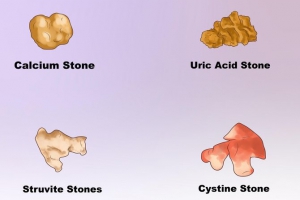
Kidney stones (calculi) are hardened mineral deposits that form in the kidney. They originate as microscopic particles and crystals and develop into stones over time. The medical term for this condition is nephrolithiasis, or renal stone disease.
The kidneys filter waste products from the blood and add them to the urine that the kidneys produce. When waste materials in the urine do not dissolve completely, crystals and kidney stones are likely to form. These stones may stay in the kidney for a long time or they may pass out of the kidney and become lodged in the tube that carries urine from the kidney to the bladder (ureter). If left untreated, the kidney may swell and lose its function.
Kidney stones form when there is a high level of calcium (hypercalciuria), oxalate (hyperoxaluria), or uric acid (hyperuricosuria) in the urine; a lack of citrate in the urine; or insufficient water in the kidneys to dissolve waste products. The kidneys must maintain an adequate amount of water in the body to remove waste products. If dehydration occurs, high levels of substances that do not dissolve completely (e.g., calcium, oxalate, uric acid) may form crystals that slowly build up into kidney stones.
Urine normally contains chemicals—citrate, magnesium, pyrophosphate—that prevent the formation of crystals. Low levels of these inhibitors can contribute to the formation of kidney stones. Of these, citrate is thought to be the most important.
Small, smooth kidney stones may remain in the kidney or pass without causing pain (called "silent" stones). Stones that lodge in the tube that carries urine from the kidneys to the bladder (ureter) results in severe pain that begins in the loin and lower back and radiates to the groin or front of the lower abdomen. The pain may not be related to the size or location of the stone.
A "small" stone (usually 4 mm in diameter or less) has a 90% chance of spontaneous passage. Stones that are 4 to 6 mm in diameter has a 50% of spontaneous passage. Stones larger than 6 mm in diameter has less than 10% chance of passage.
Other symptoms of kidney stones may include the following:
Blood in the urine (hematuria)
Increased frequency of urination
Nausea and vomiting
Pain during urination (stinging, burning)
Tenderness in the abdomen and kidney region
Urinary tract infection (fever, chills, loss of appetite)
Diagnosis of renal stone disease involves a medical history, physical examination, laboratory evaluation, and imaging tests. The physician determines if the patient has a history of kidney stones, documents past medical conditions, and evaluates present symptoms. Physical examination may be difficult if the patient is experiencing severe pain and is unable to remain still. Lightly tapping on the kidney region often worsens the pain. Fever may indicate a urinary tract infection that requires antibiotics.
Laboratory tests include urinalysis to detect the presence of blood (hematuria) and bacteria (bacteriuria) in the urine. Other tests include blood tests for creatinine (to evaluate kidney function), BUN and electrolytes (to detect dehydration), calcium (to detect hyperparathyroidism), and a complete blood count (CBC; to detect infection).
See our full list of Singapore Urologists here.







